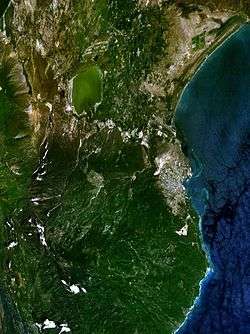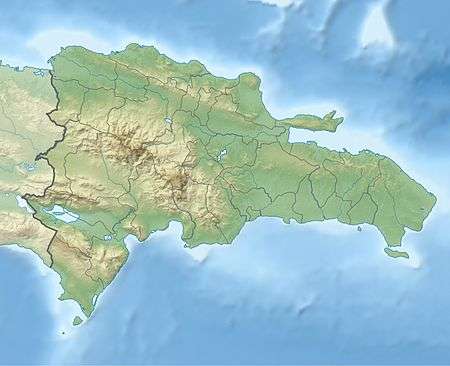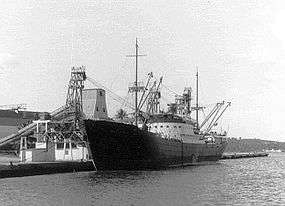Barahona, Dominican Republic
Barahona, also known as Santa Cruz de Barahona, is the main city of the Barahona Province, in the south of the Dominican Republic. It is one of the most important cities on the island, with a very active port and many ecotourism attractions. The city is also a centre of sugar production and industry.
Barahona | |
|---|---|
| Santa Cruz de Barahona | |
 Google Earth image of Barahona. | |
 Seal | |
 Barahona | |
| Coordinates: 18°12′N 71°06′W | |
| Country | |
| Province | Barahona |
| Founded /Founder. =Toussaint L'ouverture | 1802 |
| Municipality since | 1858 |
| Area | |
| • Total | 163.02 km2 (62.94 sq mi) |
| Elevation | 10 m (30 ft) |
| Population (2012)[3] | |
| • Total | 138,159 |
| • Density | 850/km2 (2,200/sq mi) |
| • Demonym | Barahonero(a) |
| Municipal Districts | 3 |
| Climate | Aw |
History
Since the 18th century, the region was occupied by fishermen and people who came here to cut trees. When Toussaint L'Ouverture took the eastern part of the Hispaniola island in the name of France, he gave the order to create the town of Barahona in 1802 as part of the Ozama Department.[4] After the Independence in 1844, Barahona was a military post of the Azua Province.
In 1858, Barahona was elevated to the category of municipality. When the province was created in 1881, Barahona was made its head municipality.
Climate
Under the Köppen climate classification, Barahona has a tropical savanna climate.[5] Temperatures tend to remains steady throughout the year, with mean temperatures ranging from a low of 24.8 °C (76.6 °F) in January to a high of 28.0 °C (82.4 °F) in July. In terms of dry and wet seasons, Barahona has two distinctive wet seasons with a peak in precipitation from May to June followed by drought-like conditions in July and August (due to the Azores high being located in the central Atlantic, inhibiting the formation of clouds and rain) and another peak in precipitation from September to October. This precipitation pattern is due to the movement and the position of the Azores high throughout the year. The dry season mainly runs through December to April. Even in the drier months, precipitation can still occur with February receiving just under 30 mm (1.2 in). Sunshine is abundant throughout the year, averaging over 3200 hours.
| Climate data for Barahona (1961–1990) | |||||||||||||
|---|---|---|---|---|---|---|---|---|---|---|---|---|---|
| Month | Jan | Feb | Mar | Apr | May | Jun | Jul | Aug | Sep | Oct | Nov | Dec | Year |
| Record high °C (°F) | 33.2 (91.8) |
34.0 (93.2) |
33.8 (92.8) |
34.5 (94.1) |
34.7 (94.5) |
34.2 (93.6) |
35.6 (96.1) |
37.5 (99.5) |
35.8 (96.4) |
34.5 (94.1) |
34.0 (93.2) |
33.0 (91.4) |
37.5 (99.5) |
| Average high °C (°F) | 29.3 (84.7) |
29.2 (84.6) |
29.5 (85.1) |
30.0 (86.0) |
30.3 (86.5) |
30.7 (87.3) |
31.7 (89.1) |
31.9 (89.4) |
31.5 (88.7) |
30.7 (87.3) |
30.6 (87.1) |
29.8 (85.6) |
30.4 (86.7) |
| Daily mean °C (°F) | 24.8 (76.6) |
25.0 (77.0) |
25.6 (78.1) |
26.3 (79.3) |
26.8 (80.2) |
27.4 (81.3) |
28.0 (82.4) |
27.9 (82.2) |
27.4 (81.3) |
26.6 (79.9) |
26.2 (79.2) |
25.3 (77.5) |
26.4 (79.5) |
| Average low °C (°F) | 20.3 (68.5) |
20.7 (69.3) |
21.6 (70.9) |
22.6 (72.7) |
23.3 (73.9) |
24.1 (75.4) |
24.3 (75.7) |
24.0 (75.2) |
23.3 (73.9) |
22.6 (72.7) |
21.8 (71.2) |
20.7 (69.3) |
22.4 (72.3) |
| Record low °C (°F) | 15.0 (59.0) |
15.0 (59.0) |
17.0 (62.6) |
18.0 (64.4) |
19.2 (66.6) |
20.0 (68.0) |
19.5 (67.1) |
20.0 (68.0) |
20.0 (68.0) |
19.6 (67.3) |
16.6 (61.9) |
15.5 (59.9) |
15.0 (59.0) |
| Average rainfall mm (inches) | 30.4 (1.20) |
29.3 (1.15) |
45.1 (1.78) |
64.1 (2.52) |
168.5 (6.63) |
129.5 (5.10) |
38.1 (1.50) |
65.1 (2.56) |
143.7 (5.66) |
184.9 (7.28) |
75.6 (2.98) |
44.4 (1.75) |
1,018.7 (40.11) |
| Average rainy days (≥ 0.1 mm) | 3.7 | 3.2 | 3.9 | 6.1 | 10.6 | 8.2 | 3.8 | 5.1 | 8.8 | 10.6 | 4.8 | 2.4 | 71.2 |
| Average relative humidity (%) | 73.0 | 72.6 | 71.5 | 71.9 | 75.6 | 75.8 | 72.0 | 72.9 | 76.3 | 78.4 | 75.1 | 72.8 | 74.0 |
| Mean monthly sunshine hours | 259.6 | 248.8 | 286.7 | 271.5 | 261.0 | 264.7 | 289.3 | 286.5 | 243.2 | 259.0 | 267.7 | 268.6 | 3,206.6 |
| Source 1: World Meteorological Organization[6] | |||||||||||||
| Source 2: NOAA[7] | |||||||||||||
Economy

The main economic activity of the province is agriculture; the main product in the municipality is a very good coffee ("Barahona Type Coffee"), grown in the mountains of Eastern Bahoruco.
There are also some important industries, mainly to produce textiles to send to other countries, and sugar in the Ingenio Barahona ("Barahona Sugar Factory").
Transport
Although Barahona does not have a highly developed transportation system, the city has a sea port, which receives many ferries from different points in the Caribbean, and an airport, which has been reactivated with many flights a week to Punta Cana via Santo Domingo. Authorities provided the airport with a fuel station park, allowing facilities to the airliners that could operate in the airport in the future. The airport is the well known Maria Montez International Airport located about 10 minutes from the city center. The port is located about 5 minutes away from the city center.
Notable natives and residents
- Julio Lugo, shortstop for the Boston Red Sox
- Ruddy Lugo, relief pitcher for the Oakland Athletics
- Maria Montez, actress
- Ludo Vika, actress/comedian
- Edison Volquez, pitcher for the Kansas City Royals
References
- Superficies a nivel de municipios, Oficina Nacional de Estadistica Archived April 17, 2009, at the Wayback Machine
- De la Fuente, Santiago (1976). Geografía Dominicana (in Spanish). Santo Domingo, Dominican Republic: Editora Colegial Quisqueyana.
- Censo 2012 de Población y Vivienda, Oficina Nacional de Estadistica
- López Reyes, Oscar (1999). Historia del desarrollo de Barahona: Narración e interpretación (in Spanish). Santo Domingo: Mediabyte.
- Peel, M. C.; Finlayson, B. L. & McMahon, T. A. (2007). "Updated world map of the Köppen–Geiger climate classification" (PDF). Hydrol. Earth Syst. Sci. 11: 1633–1644. doi:10.5194/hess-11-1633-2007. ISSN 1027-5606.
- "World Weather Information Service - Barahona". World Meteorological Organization. Retrieved February 23, 2013.
- "Climate Normals for Barahona 1961-1990". National Oceanic and Atmospheric Administration. Retrieved February 23, 2013.